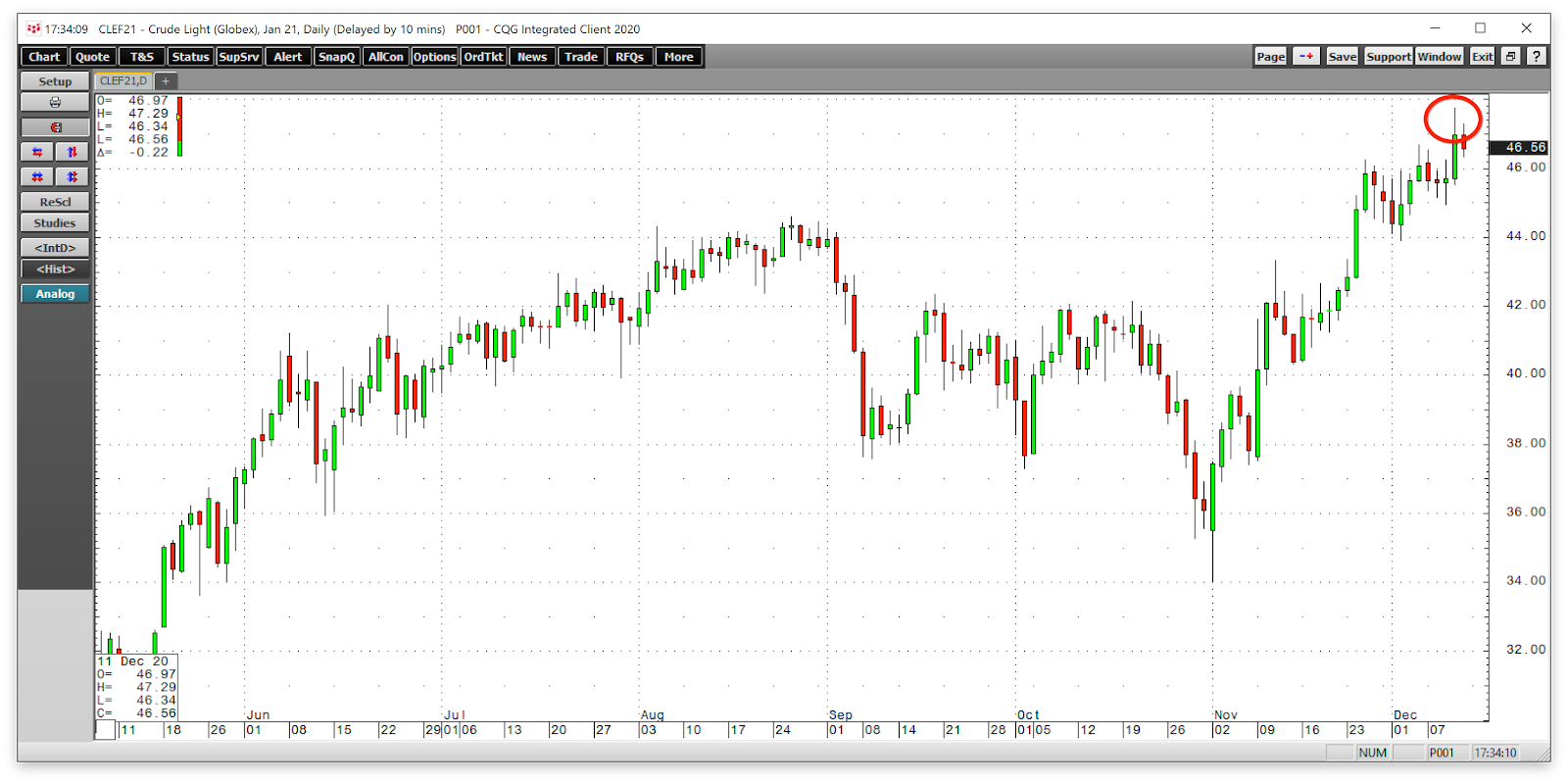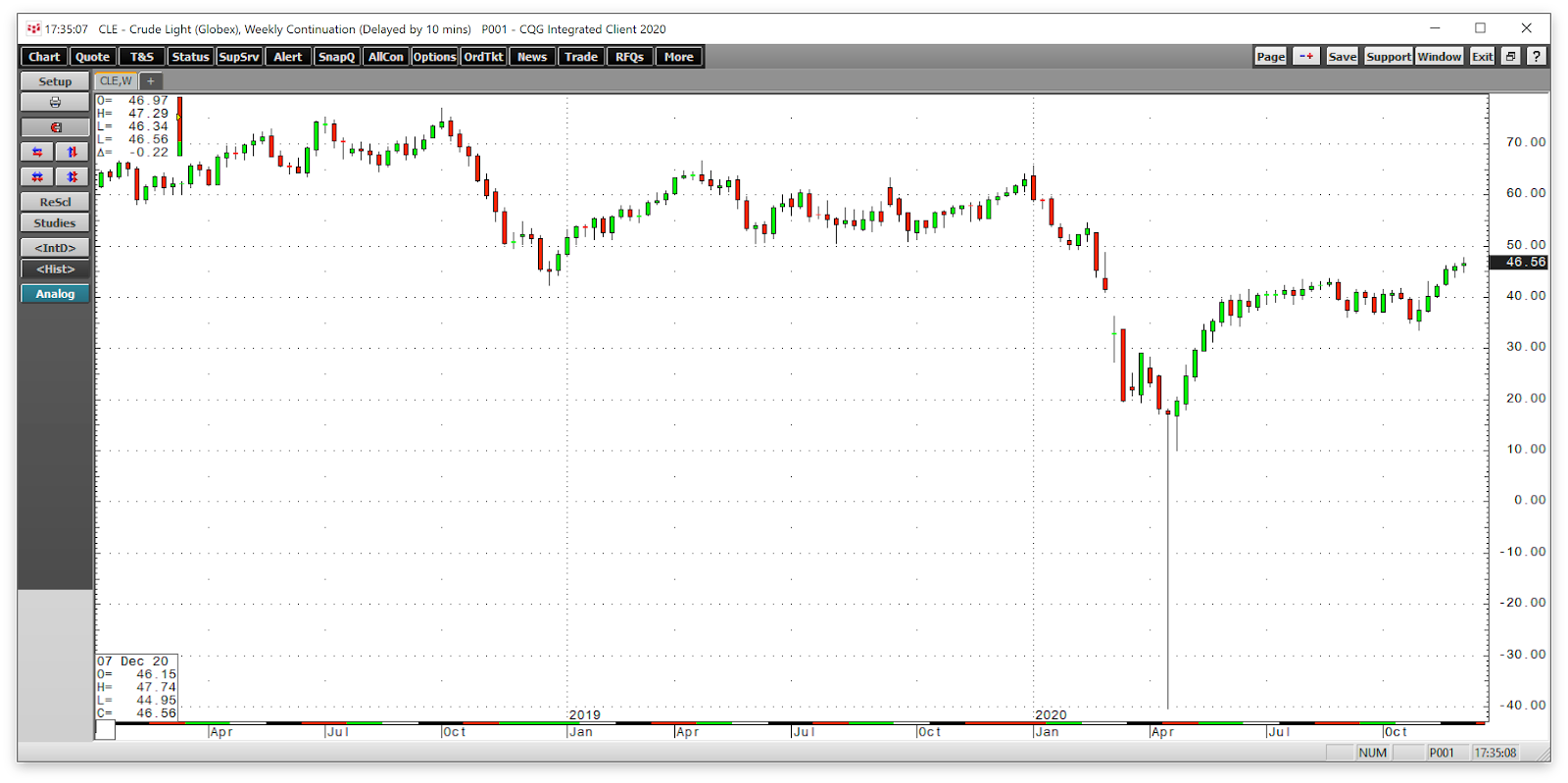-
The OPEC+ news was bullish
-
The new administration’s energy policy will be bullish
-
The trend is higher – Expect a post-pandemic rally in 2021
-
Short-term bullish, long-term ugly
-
2020 has been a very volatile year in the crude oil market. At the start of the year, a face-off between the U.S. and Iran in Iraq caused the price of the energy commodity to rise in the two benchmark oil futures markets. The Middle East is home to over half the world’s crude oil reserves, so the conflict prompted supply concerns. The nearby WTI price on NYMEX peaked at $65.65 in early January, and the Brent price on ICE (NYSE:ICE) rose to $71.99 per barrel.
Less than five months later, the demand destruction created by the global pandemic pushed the price of WTI futures below zero for the first time to a low of negative $40.32 on the expiring May contract. Nearby Brent futures fell to the lowest price of this century at $16.
Since then, production declines have balanced the energy commodity’s fundamental equation and lifted prices. Optimism over a vaccine in 2021 also pushed prices higher. Crude oil recently reached its highest price since early March 2020 on WTI and Brent futures. The trend in the energy commodity remains higher at the end of last week.
The United States Oil Fund (NYSE:USO) and the United States Brent Oil Fund (NYSE:BNO) move higher and lower with the prices of the two benchmark petroleum futures contracts.
The OPEC+ News Was Bullish
The latest OPEC+ meeting created more than a little anxiety in the oil futures arena. The disagreement between Saudi Arabia and Russia earlier this year led to a flood of output and pushed the price of WTI below zero and Brent to its lowest level of this century. On Nov. 30, the Saudis and UAE did not agree on the quota levels going into 2021. Russia likely mediated the dispute as they have over the past four years. Russia is OPEC’s most influential force, even though it is not a member. Russia puts the plus in OPEC+.
On Dec. 3, the cartel announced it would taper output cuts by 500,000 barrels per day in January 2021 to a total cut of 7.2 mbpd. OPEC+ will continue to taper at a rate of 500,000 in February and March but will meet each month to assess the state of supply and demand fundamentals that could prompt adjustments. The oil market breathed a sigh of relief after the biannual meeting and change in production policy.

-
Source: CQG
As the daily chart of NYMEX January crude oil futures highlights, the price of the energy commodity rose to a new high of $47.74 on Dec. 10, days after OPEC+’s announcement. The cartel’s production policy was bullish for crude oil. Russia, Saudi Arabia, and other cartel members are now waiting for a substantial change in international petroleum fundamentals in the world’s leading producing nation.
New Administration’s Energy Policy Will Be Bullish
President-elect Joe Biden pledged to adopt a greener path towards energy in 2021 and beyond. A stricter regulatory environment, rejoining the Paris climate accords, and moving away from fossil fuels towards alternative energy sources encapsulates the incoming administration’s plans.
Incoming Presidents typically receive support from legislators on their initiatives because a winning campaign platform reflects the voters’ will. A majority in the House of Representatives and the Senate only makes the path of legislative success easier. President-elect Biden already has his majority in the House. The Senate’s majority will come down to a pair of runoff elections in Georgia on January 5.
If Democrats win both seats, the fifty-fifty tie between Democrats and Republicans will hand the Senate to Democrats, as Vice President-elect Kamala Harris will have the deciding vote. It would also allow for more pressure from the Democrat’s progressive wing to adopt a greener path towards energy. Without the need for compromise with a Republican Senate, environmental initiatives are likely to be more dramatic. In any case, US energy policy will experience a substantial shift, leading to lower fossil fuel production.
As U.S. production declines over the coming years, OPEC+’s influence in the crude oil market will rise from the ashes. If OPEC members and Russia can produce at three-quarters of their capacity and the price doubles from current levels, they will be massive winners.
Trend Is Higher: Expect Post-Pandemic Rally In 2021
The April 20 low that took the landlocked WTI crude oil price below zero was a classic blow-off low.

-
Source: CQG
As the weekly chart highlights, crude oil has been making higher highs since April, with the latest peak coming on Dec. 10. The next upside milestone is the psychological $50 level on nearby NYMEX futures. Above there, technical resistance stands at the $54.50, mid-February high, and the $65.65 2020 peak.
OPEC is likely to continue to taper in 2021, and US production should decline. As vaccines create herd immunity to COVID-19, we could see a surge in energy demand, supporting the crude oil price. I expect a post-pandemic rally. Moreover, global monetary and fiscal policies are highly inflationary. A falling dollar also supports the price of all commodities, and crude oil is no exception.
Short-Term Bullish, Long-Term Ugly
The short-term prospects for crude oil remain bullish. We could see far higher prices in 2021. However, the long-term picture remains problematic as the world moves towards alternative energy sources. Climate change and environmental concerns foster the trend away from hydrocarbons.
-
Technology is changing the demand side of the fundamental equation for crude oil, gas, coal, and other fossil fuels. Electric vehicles will continue to replace gasoline-powered automobiles and diesel-powered trucks. However, the coming year could provide some shocks in the oil market.
The shift towards alternative power sources will be slow and steady, and traditional supplies could decline as supply could struggle to keep pace with demand. While the US and Europe could accelerate the trend towards alternative energy sources, over one-third of the world’s population resides in China and India. Economic growth in the two nations will continue to increase the demand for hydrocarbons, which will fill the pockets of OPEC+ members in the short-term.
I am bullish on crude oil based on the current trend. The energy commodity is likely to continue to take the stairs higher as pricing and production power shifts from the U.S. to the cartel and Russia. A rapid change in U.S. production policy could create near-term shortages as the world experiences a surge in post-pandemic demand in the coming year.
- English (UK)
- English (India)
- English (Canada)
- English (Australia)
- English (South Africa)
- English (Philippines)
- English (Nigeria)
- Deutsch
- Español (España)
- Español (México)
- Français
- Italiano
- Nederlands
- Português (Portugal)
- Polski
- Português (Brasil)
- Русский
- Türkçe
- العربية
- Ελληνικά
- Svenska
- Suomi
- עברית
- 日本語
- 한국어
- 简体中文
- 繁體中文
- Bahasa Indonesia
- Bahasa Melayu
- ไทย
- Tiếng Việt
- हिंदी
How High Can Crude Oil Go?
Latest comments
Loading next article…
Install Our App
Risk Disclosure: Trading in financial instruments and/or cryptocurrencies involves high risks including the risk of losing some, or all, of your investment amount, and may not be suitable for all investors. Prices of cryptocurrencies are extremely volatile and may be affected by external factors such as financial, regulatory or political events. Trading on margin increases the financial risks.
Before deciding to trade in financial instrument or cryptocurrencies you should be fully informed of the risks and costs associated with trading the financial markets, carefully consider your investment objectives, level of experience, and risk appetite, and seek professional advice where needed.
Fusion Media would like to remind you that the data contained in this website is not necessarily real-time nor accurate. The data and prices on the website are not necessarily provided by any market or exchange, but may be provided by market makers, and so prices may not be accurate and may differ from the actual price at any given market, meaning prices are indicative and not appropriate for trading purposes. Fusion Media and any provider of the data contained in this website will not accept liability for any loss or damage as a result of your trading, or your reliance on the information contained within this website.
It is prohibited to use, store, reproduce, display, modify, transmit or distribute the data contained in this website without the explicit prior written permission of Fusion Media and/or the data provider. All intellectual property rights are reserved by the providers and/or the exchange providing the data contained in this website.
Fusion Media may be compensated by the advertisers that appear on the website, based on your interaction with the advertisements or advertisers.
Before deciding to trade in financial instrument or cryptocurrencies you should be fully informed of the risks and costs associated with trading the financial markets, carefully consider your investment objectives, level of experience, and risk appetite, and seek professional advice where needed.
Fusion Media would like to remind you that the data contained in this website is not necessarily real-time nor accurate. The data and prices on the website are not necessarily provided by any market or exchange, but may be provided by market makers, and so prices may not be accurate and may differ from the actual price at any given market, meaning prices are indicative and not appropriate for trading purposes. Fusion Media and any provider of the data contained in this website will not accept liability for any loss or damage as a result of your trading, or your reliance on the information contained within this website.
It is prohibited to use, store, reproduce, display, modify, transmit or distribute the data contained in this website without the explicit prior written permission of Fusion Media and/or the data provider. All intellectual property rights are reserved by the providers and/or the exchange providing the data contained in this website.
Fusion Media may be compensated by the advertisers that appear on the website, based on your interaction with the advertisements or advertisers.
© 2007-2025 - Fusion Media Limited. All Rights Reserved.
